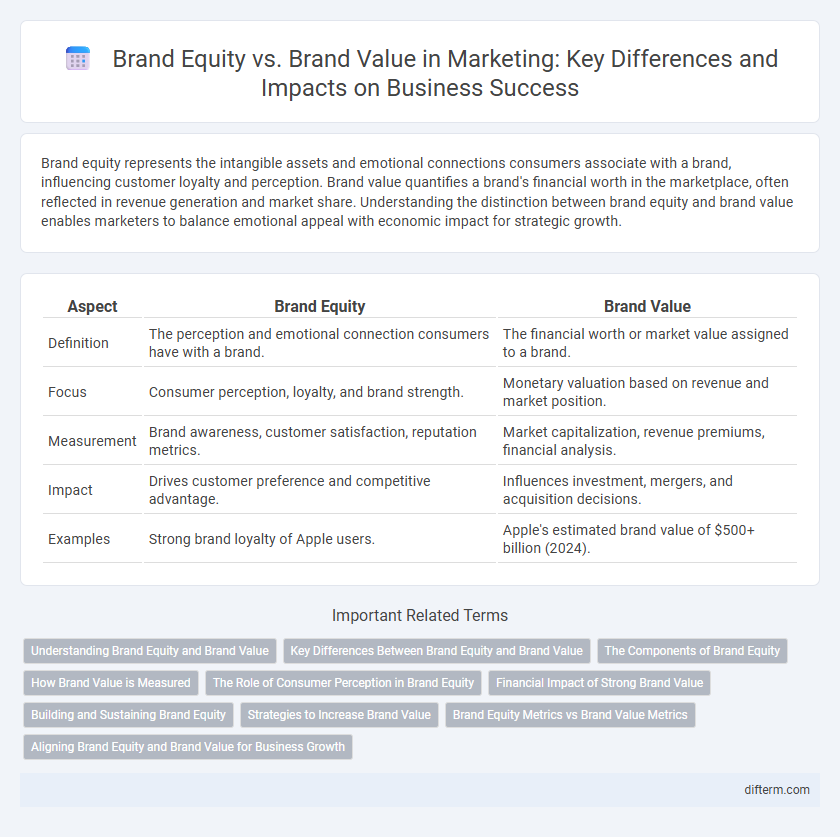Brand equity represents the intangible assets and emotional connections consumers associate with a brand, influencing customer loyalty and perception. Brand value quantifies a brand's financial worth in the marketplace, often reflected in revenue generation and market share. Understanding the distinction between brand equity and brand value enables marketers to balance emotional appeal with economic impact for strategic growth.
Table of Comparison
| Aspect | Brand Equity | Brand Value |
|---|---|---|
| Definition | The perception and emotional connection consumers have with a brand. | The financial worth or market value assigned to a brand. |
| Focus | Consumer perception, loyalty, and brand strength. | Monetary valuation based on revenue and market position. |
| Measurement | Brand awareness, customer satisfaction, reputation metrics. | Market capitalization, revenue premiums, financial analysis. |
| Impact | Drives customer preference and competitive advantage. | Influences investment, mergers, and acquisition decisions. |
| Examples | Strong brand loyalty of Apple users. | Apple's estimated brand value of $500+ billion (2024). |
Understanding Brand Equity and Brand Value
Brand equity refers to the intangible assets and consumer perceptions associated with a brand, including brand loyalty, recognition, and overall reputation in the marketplace. Brand value quantifies this equity in financial terms, reflecting the monetary worth of a brand based on market performance, revenue generation, and competitive advantage. Understanding the distinction between brand equity and brand value is crucial for marketers to strategically invest in brand-building activities that enhance both consumer perception and financial returns.
Key Differences Between Brand Equity and Brand Value
Brand equity represents the consumer perception and emotional connection with a brand, reflecting loyalty, recognition, and trust built over time. Brand value quantifies the financial worth of a brand, often measured through market capitalization, revenue premium, or discounted cash flow analysis. Key differences include brand equity being qualitative and customer-focused, whereas brand value is quantitative and investor-focused.
The Components of Brand Equity
Brand equity consists of key components including brand awareness, brand loyalty, perceived quality, and brand associations, which collectively influence consumer perception and preference. These elements drive customer choice and contribute to a brand's competitive advantage in the marketplace. Strong brand equity enhances customer retention, supports premium pricing, and increases overall market share.
How Brand Value is Measured
Brand value is measured through financial metrics such as revenue generated, market share, and the premium customers are willing to pay, reflecting the monetary worth of a brand. Methods like discounted cash flow analysis and brand valuation models, including Interbrand and BrandZ, quantify brand value by estimating future earnings attributable to the brand. Evaluating brand value involves analyzing consumer perception, competitive positioning, and economic performance to provide a comprehensive financial assessment.
The Role of Consumer Perception in Brand Equity
Consumer perception fundamentally shapes brand equity by influencing customer loyalty, perceived quality, and emotional connection, which collectively determine a brand's strength in the marketplace. Unlike brand value, which quantifies a brand's financial worth, brand equity encompasses intangible assets derived from consumer attitudes and experiences. Positive consumer perception enhances brand equity by driving preference and advocacy, ultimately impacting long-term profitability and competitive advantage.
Financial Impact of Strong Brand Value
Strong brand value drives significant financial impact by enhancing customer loyalty, allowing premium pricing, and increasing market share. Companies with high brand equity often experience greater revenue stability and improved investor confidence, leading to higher stock valuations and acquisition premiums. The measurable financial benefits of a powerful brand include increased profitability and sustained competitive advantage in the marketplace.
Building and Sustaining Brand Equity
Building and sustaining brand equity involves consistently delivering high-quality products and maintaining strong customer relationships to enhance brand loyalty and recognition. Effective brand equity drives long-term competitive advantage by increasing customer trust and perceived value, which directly influences market share and pricing power. Unlike brand value, which quantifies the financial worth of a brand, brand equity emphasizes the emotional and perceptual impact on consumers, making it essential for sustainable marketing success.
Strategies to Increase Brand Value
Strategies to increase brand value focus on enhancing customer loyalty, boosting perceived quality, and strengthening brand associations through consistent messaging and exceptional experiences. Investing in targeted advertising campaigns, leveraging social media engagement, and delivering innovative products build emotional connections that elevate brand equity and translate into higher financial worth. Measuring brand value regularly with metrics such as brand valuation models helps optimize marketing investments for sustained growth.
Brand Equity Metrics vs Brand Value Metrics
Brand equity metrics measure consumer perceptions, brand awareness, loyalty, and emotional connections, reflecting the intangible assets that influence customer behavior. Brand value metrics quantify the financial worth of a brand based on revenues, market share, and overall economic impact on the company's balance sheet. Understanding the distinction between brand equity metrics and brand value metrics enables marketers to balance strategic brand management with financial performance assessment.
Aligning Brand Equity and Brand Value for Business Growth
Aligning brand equity and brand value significantly enhances business growth by creating a consistent and authentic customer experience that drives loyalty and market differentiation. Strong brand equity, reflected in positive perceptions and emotional connections, should translate into measurable brand value through increased revenue, market share, and financial performance. Integrating brand equity initiatives with value-driven strategies ensures sustained competitive advantage and long-term profitability.
Brand equity vs brand value Infographic

 difterm.com
difterm.com